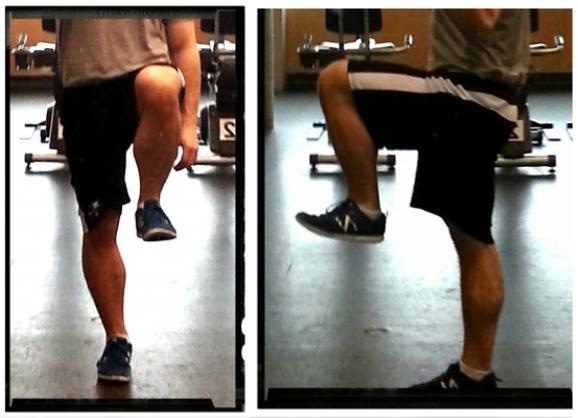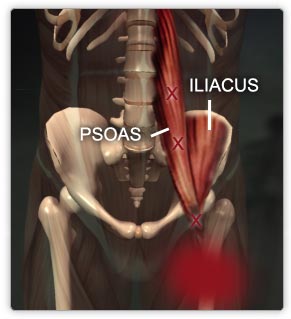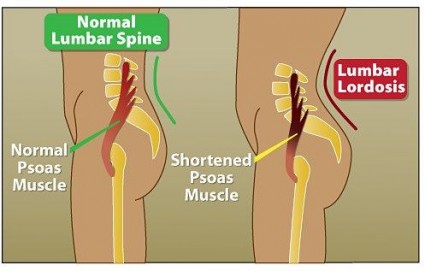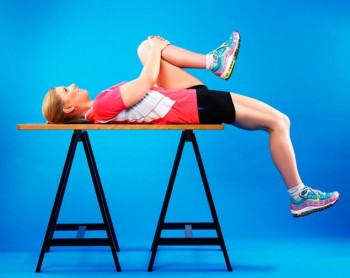The Psoas is one of those
“muscles of the minute”.
Just like the Glute Medius, Vastus Medialus and Rhomboids before it, right now EVERYTHING is somehow linked to a Psoas dysfunction issue.
This isn’t true….but it kinda is.
In the last 2 years I’ve had more and more clients than ever with Psoas issues.
But what is true is that the Psoas is waaaay more important than we used to think and in a lot of people, especially Desk Jockeys, it’s either not doing its job, it’s tight as hell or both.
Either way it can and probably is contributing to your back pain and/ or anterior hip pain.
Especially if you sit all day.
What and where the Psoas is:
It’s a muscle that connects the front of your leg at about the hip to your spine and attaches along several lower vertebra:
Photo From realbodywork.com
What it does:
The Psoas flexes the hip (knee to the chest) and arches the lower back.
It’s active in high knee raises (once the hip flexes past 90 degrees). Lift your leg when the crease at the top of your bent knee is parallel with the crease in your hip, the Psoas is doing that.

Photos taken from my phone
The Problem:
Sitting….Desk Jockey Syndrome.
We do too much of it and not a lot of activities that force the Psoas to activate like sprinting and kicking.
Because of that the Psoas tends to become short and weak.
When this happens the Psoas is incapable of helping to stabilize and control the movement of the Femur in the hip socket which leads to pain in the front of the hip at the top of the crease of the hip and/ or pain and stiffness in the lower back.
Photo from www.physio-therapy.cz
How to Fix it:
Stretch it!
The Psoas is incredibly difficult to do soft tissue work on for 99% of people so your best hope to restore normal length is through stretching. There are a million different variations of this stretch that do basically the same thing.
Try them and see which one gives you the best stretch.
Keep in mind to squeeze the glute of the foot that is on the bench to bring the pelvis into neutral positioning.
You can increase the stretch by reaching overhead, arching hard and leaning back.
The Thomas Stretch (below) is probably the best stretch but who the hell has a massage table sitting around….they say you can use a bed, and I guess you can use your kitchen table.
Photo from Runnersworld UK .com
I’ve tried the bed thing and…it’s not so good….
But if you have the capabilities this is the BEST Psoas stretch.
It’s even better if you can get someone to gently push the leg of the foot that’s hanging off the table down.
The key to making this effective is to keep the hips from moving and a slight arch in the lower back the entire time.
Once you’ve restored normal length we want to keep it that way so it becomes necessary to strengthen the Psoas so it continues to do its job and doesn’t “go to sleep” and shut off again.
Strengthen it:
For the Psoas to activate the top of the knee MUST pass the crease in the top of the hip.
If this doesn’t happen then the Psoas doesn’t activate and noting is happening, your wasting your time.
By virtue of the band this can be the easiest exercise to begin with if you have trouble with knee flexion. Obviously you can make this exercise much harder by increasing band tension.
Key Points:
- Keep a slight arch in the lower back, just like you would normally have.
- Abs tight and hips LOCKED.
- Don’t let the hips roll back or shift while pulling.
- Place the hands under the lower back arch, the minute you feel pressure the hips have “rolled” back and the hip is no longer creating flexion. Stop the exercise.
Remember, the knee MUST pass the crease in the hip.
Once you’ve mastered this it’s time to move to a sitting position which will add an extra degree of difficulty because, unlike lying on the floor, gravity will load the hips.
Yes, this is the exercise your grandma did after breaking her hip. But you’re going to do it right.
Key Points:
- Sit tall with a slight arch in the lower back and stay tall.
- Seat should be at a height that creates a 90 degree angle at the hip and knee. A little lower or higher is fine, but shoot for 90.
- Keep the abs tight and hips LOCKED in place.
- Do not let the lower back move at all during the exercise.
- No leaning back or hiking the hips.
The next step in the process of Psoas domination activation is Hip Flexion while standing.
Again, NO LEANING or shifting of weight. Stay tall and locked in.
Key Points:
- Stand tall, lock the knee of the leg you’re standing on.
- Keep a slight arch in your lower back the whole time.
- No hiking or rotating the hip.
- Only flex the hip.
Remember, pain in the front part of the hip OR the back can be an indication of a Psoas issue and it WILL get worse if you don’t address it.
Even if you don’t have pain but you’re sitting a lot you should start stretching and strengthening your Psoas…it’s preventative maintenance folks.






Thanks Roy, very informative. Just recently got told my Psoas is shortened and not doing its job properly. Having a lot of lower back / pelvic instability issues as a result of this. Will try some of the variations to stretch to have provided above. Cheers
Oliver,
Good luck, it usually takes some time….a few weeks to a few months for a shortened Psoas to really normalize, but if you’re consistent you should have good progress.
how do u come to know that Psoas is working normally?
Nado,
You can do the knee raise test that’s in the article.
Stand tall, raise the knee straight up as high as possible WITHOUT leaning back or allowing the hip to roll under or you to lean over…..straight up.
It’s not perfect but is accurate most of the time.
Hi , just some thoughts from me. Most people who have weak psoas , tend to have hypotonic TFL or rectus femoris. Your exercises would not help such people , and may further aggravate their issues.
Ian,
I appreciate your comment…but I think you’re either confusing terms (hypotonic/ hypertonic) or you’ve gotten some bad information.
If someone has a hypotonic (underactive) Rectus femoris and or TFL none of these would exacerbate that issue. If anything they would help to restore normal functioning by flexing the hip/ creating tension and restoring the length tension relationship and firing patterns of the hip flexors..
Most people with a weak Psoas tend to be hypertonic (overactive) in the Rectus and TFL and underactive in the Psoas as Gluteals. In general, more people have this condition,desk jockey/ Janda’s Lower Crossed Syndrome than the reverse. Shirley Sahrmann has also published quite a bit of work on this also.
Did you mean hypertonic?
Hi, going through all the symptoms hip, pelvic and back pain and getting all the tight muscles as well, just wondering how often I should be doing these exercise’s and after stretching should I just be walking for excercise or can I do other physical activities as well like running and basketball those types of things??
Hi, going through all the symptoms hip, pelvic and back pain and getting all the tight muscles as well, just wondering how often I should be doing these exercise’s and after stretching should I just be walking for excercise or can I do other physical activities as well like running and basketball those types of things??
Raul,
Your best bet, if you’re in a lot of pain is to go see a physical therapist/ physio in your area and get an evaluation done. Theoretically, you could do these exercises everyday. But it would be best to have an eval and know exactly what’s going on, you may, and probably need a more comprehensive program to treat what’s going on.
Thanks Roy I have had PT numerous times and it’s funny because when I mentioned that I sit a lot at work and thought it could be my psoas the doctors and therapists thought I was dum for even mentioning it, this started right after I had a back injury but it’s spinal steno thesis which I’ve had since I was 17 I’m 49 now and this is my first issue with the psoas muscle and I have been trying your excercise’ and I feel great I have no tightness in my hip and pelvic areas anymore and most of my muscle tightness has gone away I was just wondering how many reps and sets for each excercise.
Once again thanks I’ve been dealing with this issue for 2 years and I’m finally getting relief.
Raul,
Sets and reps are really, as many as you need and can do properly.
For the most part if you’re doing 2-3 sets of 10-15 reps with really good tight form. I think you’d be in a good place, and you can cut that back to just one set of 10-20 reps once everything in back in order, just as preventative maintenance.
Thanks for the article. Could be a tight hip the cause of a (single) foot pointing out? Thank you
Potentially, yeah it could. Sometimes, a toe pointing out is a weak or underactive glute. Sometimes it’s structural so you really want to get that evaluated by a professional. They have to see it and test it to see what the root cause is.
I am 57 years old, very athletic and have had a misdiagnosed problem with my psoas for 32 years and diagnosed it myself when I aggravated it and developed internal snapping hip, yet 3 doctors didn’t have a clue as to what to do. Internal snapping hip is an almost certain indicator of iliopsoas tendonitis. I also developed TFL and IT band pain. Long story made short I had a knot in my gluteus medius and got rid of it with a deep tissue massage and when it came back I used a softball that wasn’t so soft. When I determined that it was a big part of the problem and began using the softball I eliminated my TFL/ITB pain. Next I dangled from pull up bars (standing one-legged on a stool or even a curb would have the same effect) and released my psoas and my groin pain was tremendously mitigated. I do this for 3 – 30 second intervals. The theory is that your leg dangles out of its socket a bit and releases the psoas. After doing both of these I was able to resume cardio exercises and it made an unbelievable difference to me. I am not out of the woods yet but can see the path and I need to strengthen and retrain my psoas to get there.
Dave,
Glad you got relief.
As you move forward you may want to look into strengthening your glutes too. Often a Psoas issue is, at it’s core, a glute weakness/ activation issue that migrates to the Psoas. Not always, but 90% of the time…
Hi! Im 22 years old. Im fond of playing computer games. But im having difficulty rising from a seated position. My knees are weak and i think my flutes aren’t firing. When i walk i use a walker for assistance because i find it hard to lift my leg forward. Would i benefit from this exercise? Im really desperate to find a solution. before i had this i was active i play ball and even do run. Im waiting for your response. Hope you help me.
Matthew,
Sounds like you have a lot going on. if I were you I would go see a physician and then a good physical therapist. I think that would be your best bet at this point.
Good luck, keep me posted.
I have been to my physician all results were normal. Mri,xray, and laboratories. I was referred to a physical therapist. She said i had weak abs, weak glutes, weak upper back. Been doing the exercises religiously. For 3 months. I was then referred again to a physician for a more thorough evaluation. I always get referred back to a PT session. As of now i stopped going to my PT sessions and decided to self diagnose my problem. From what i have observed i think i have a posterior pelvic tilt with a flat back. By the way the exercises that were given to me by my physical therapist were glute bridge, seated knee raises and a hamstring stretch. Hope you can shed a light to my problem. Thanks anyway for the quick response.
Mathew,
Based off of what you’ve presented I would think you’re right you probably do have weak abs and glutes, but I think your PT might have been on the right track too, just more conservatively than you liked.
Anyway, give these a try, along with some core and glute exercises for a few weeks and see if they help you out.
Hi, I was trying to improve my flexibility by doing leg swings (front to back, side to side) and the next day developed severe lower back pain. Sitting became impossible and standing straight wasn’t much better. The next few days the only way I could relieve the pain was to lie on my stomach with a large cushion under my hips.
Over the next few weeks or so I started developing knee problems, to the extent that now three months later I have severe pain right on the inside of my knee when I extend my leg when weight bearing. I also feel almost too upright when I attempt to run (I can’t run as the pain hurts too much, and my forward motion seems restricted).
Could the cause be a really contracted psoas – the diagram of the lumbar spine on this article in its incorrect position kind of matches the position mine lumbar would have been in during my initial recovery?
I read a knee pain article and it said trying moving around bent over, see if the pain reduces, completely bent over I could literally run without pain, just looking very weird.
Look forward to your response,
Liz
Liz,
Sorry for such a late reply and hopefully you found a solution.
Sounds like you absolutely could have a very tight psoas, and it sounds like tight hip flexors and quite possibly a lack of core and glute (hip) strength. If leaning forward/ bending over relieved the pain, that wold lead me to believe that when standing you’re really straining the structures on the anterior of the hip, and leaning forward artificially shortens them to a length they can tolerate.
I would get this checked out by a good Phyiscal Therapist if you’re still having issues.
Hi Roy. You are a genius. Thanks for the proper and detailed explanation on this controversial subject. A lot has been written about the Psoas muscle and never has it been simplified like this. Someone referred to it as “the muscle of the soul” and it kinda makes sense. I am a desk jockey supreme and I literally do these exercises daily. I gauge my Psoas health by my sex life and step up the moment I recognise that dull feeling in my back. Thanks for the simple yet effective exercises I can now add to my repertoire. Have a great one. Kenny.
Thank you for a well done reminder! Recent total left knee replacement has been doing great until returning to a desk job, and therapy is done. Flexion is about 92%, some yoga poses are just not able to do. Child pose at one time had my butt resting on the heals of my feet. It hurts to try this now, and feeling stiff. I will be looking forward to learning more from you. Nameste’